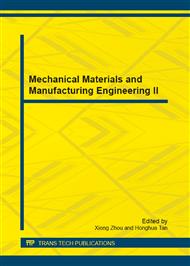[1]
S.J. Mraz, Birth of an engine blade. Machine Design, 69(14) (1997)39-44.
Google Scholar
[2]
E. P. Kruglov and G.K. Kochetova, Improvement of a technological process for ceramic core removal out of internal cavities of aircraft GTE turbine blade castings. Russian Aeronautics (Iz VUZ), 50(2) (2007) 227-229.
DOI: 10.3103/s1068799807020201
Google Scholar
[3]
A.A. Wereszczak, K. Breder, M.K. Ferber, T.P. Kirkland, E. A. Payzant, C. J. Rawn, Dimensional changes and creep of silica core ceramics used in investment casting of superalloys. Journal of Materials Science, 37(19) (2002)4235-4245.
DOI: 10.1023/a:1020060508311
Google Scholar
[4]
S. Jones and C. Yuan, Advances in shell moulding for investment casting. Journal of Materials Processing Technology, 135 (2003)258-265.
DOI: 10.1016/s0924-0136(02)00907-x
Google Scholar
[5]
E. Bassoli, A. Gatto, L. Iuliano, M. G. Violante, 3D printing technique applied to rapid casting. Rapid Prototyping Journal, 13(3) (2007) 148 -155.
DOI: 10.1108/13552540710750898
Google Scholar
[6]
P.M. Dickens, R. Stangroom, M. Greul, B. Holmer, K.K.B. Hon, R. Hovtun, R. Neumann, S. Noeken, D. Wimpenny, Conversion of RP models to investment castings. Rapid Prototyping Journal, 1(4) (1995) 4-11.
DOI: 10.1108/13552549510104401
Google Scholar
[7]
C.K. Chua, C. Feng, C.W. Lee, G.Q. Ang, Rapid investment casting: direct and indirect approaches via model maker II. The International Journal of Advanced Manufacturing Technology, 25(1-2)(2005) 26-32.
DOI: 10.1007/s00170-004-1865-5
Google Scholar
[8]
K. Dotchev and S. Soe, Rapid manufacturing of patterns for investment casting: improvement of quality and success rate. Rapid Prototyping Journal, 12(3)(2006)156-164.
DOI: 10.1108/13552540610670735
Google Scholar
[9]
K. Niihara, Bum-Sung Kim, T. Nakayama, T. Kusunose, T. Nomoto, A. Hikasa, T. Sekino, Fabrication of complex-shaped alumina/nickel nanocomposites by gelcasting process. Journal of the European Ceramic Society, 24(12) (2004) 3419-3425.
DOI: 10.1016/j.jeurceramsoc.2003.10.027
Google Scholar
[10]
M. Medraj, R. Hammond, M.A. Parvez, R.A.L. Drew, W.T. Thompson, High temperature neutron diffraction study of the Al2O3-Y2O3 system. Journal of the European Ceramic Society, 26(2006)3515–3524.
DOI: 10.1016/j.jeurceramsoc.2005.12.008
Google Scholar
[11]
Y. Venkat, S. Singh, and N. Das, Improvement in refractoriness of ceramic shells for directional solidification casting of gas turbine components International Journal of Cast Metals Research, 23(2)(2010)130-135.
DOI: 10.1179/174313309x380468
Google Scholar


